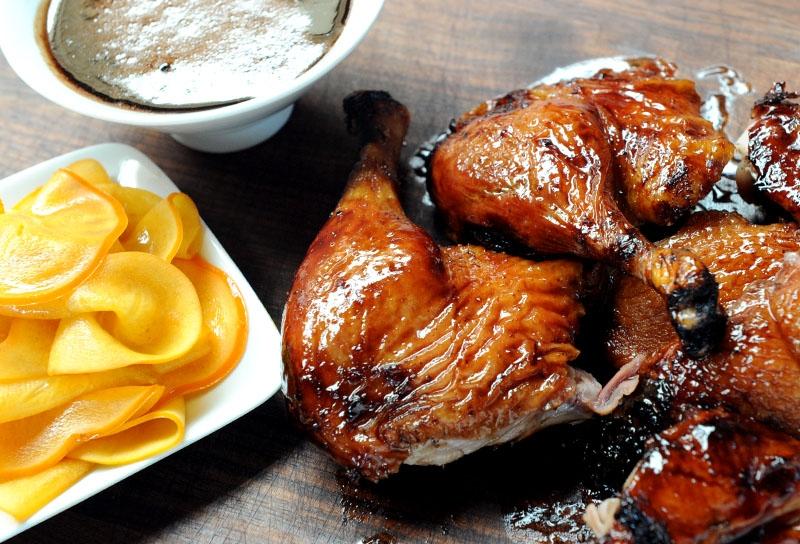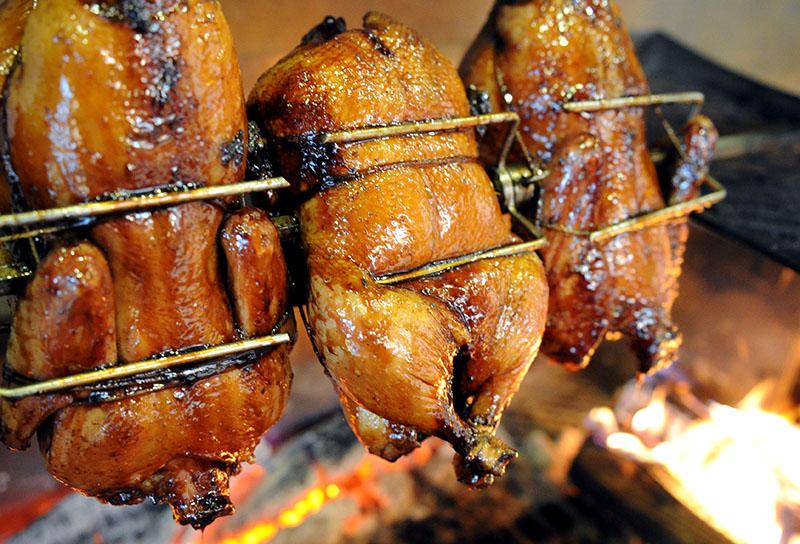Cherry Porter Glazed Duck with Pickled Persimmons
Wood-fired rotisserie duck is the real star here, but the deeply layered glaze and brightly flavored fresh pickles deserve high praises. Tart cherry juice and a rich American porter are reduced with honey and spices for a glaze you’ll want to make over and over again. The persimmons add crunch and a sweet-tart profile for an amazingly well-rounded combination.

For the pickled persimmons
- 1 cup filtered water
- 2 cups apple cider vinegar
- 1 cup honey
- 4 teaspoons kosher salt
- 2 ripe persimmons, thinly sliced on a mandolin
For the cherry porter glaze
- 12 ounces Founder’s Porter
- 12 ounces Knudsen Just Tart Cherry juice
- ½ cup honey
- ¾ cup light brown sugar
- ¼ teaspoon ground cinnamon
- ½ teaspoon freshly-grated nutmeg
- 1 Culver duck, about 5 pounds
- Kosher salt
- Freshly-ground black pepper
To make the pickled persimmons, combine the water, vinegar, honey, and salt in a saucepan. Bring to a simmer over medium heat. Place the persimmons in a non-reactive, heat-resistant bowl. Pour the liquid over the persimmons, making sure all of the fruit is submerged. Cover the bowl tightly and allow the fruit to pickle for 30 minutes. Drain off and discard all of the liquid. Refrigerate the pickled persimmons until serving time.
Prepare the glaze by combining all ingredients in a saucepan. Whisk together and bring to a simmer over high heat. Reduce to medium heat. Continue simmering, stirring frequently, until the glaze is thick, about 20 minutes. Use care not to burn the sugars. Remove from heat. Separate out a small amount to serve with the finished entrée. Reserve the rest in the pan for glazing the duck.
Prepare a wood fire for rotisserie roasting using medium-high indirect heat. For more information, see our Guide to the Gaucho Grill.
To prepare the duck, first trim the wings and remove excess fat and skin from the tail and neck areas. Truss the bird, securing the legs together and the wings close to the body. When setting up your rotisserie spit, most people’s instinct is to run the spit through the cavity, but there is another way. Duck should ideally be cooked until the internal temperature of the breast is 135°F and the thigh is 165°F. One cooking method is to partially cook the duck, then cut it up to finish. That is not ideal for the rotisserie. What does work is to run the spit sideways through the rib cage, leaving the tail end of the duck much further from the spit than the breasts. Now the parts of the bird will cook unevenly, exactly like you want! After inserting the spit, position the forks and tighten them securely. I recommend using pliers to tighten the hand screws so that the forks don’t loosen while you cook.

Once the fire is ready, mount the spit into the grill. Turn on the rotisserie motor. Ensure there is no direct heat beneath the duck by arranging your coals around the sides and away from the center. When roasting duck, it is almost always a good idea to place a pan below to catch the fat and lessen the chance of a grease fire.
Once the skin is starting to brown, begin basting generously with the glaze (you may need to warm it back up if it has gotten too thick). Roast until the thigh meat has cooked through (165°F), about 90 minutes of total roasting time, basting frequently.
Remove the spit from the grill, and the duck from the spit. Carve and serve with the pickled persimmons and some extra glaze.
Enjoy!

